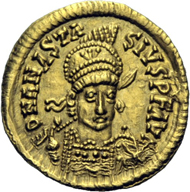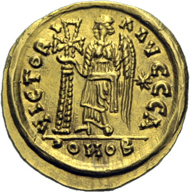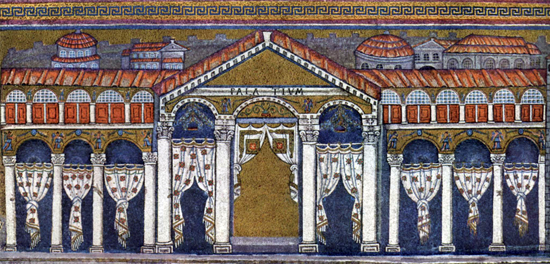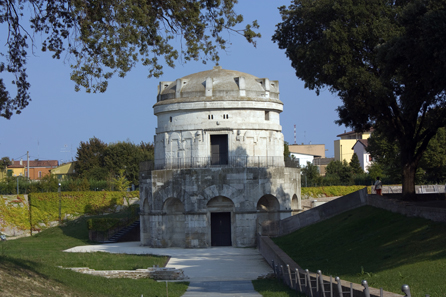Hardly anyone in the Western Roman Empire took any notice when, in 476 AD, Odoacer deposed the last, politically insignificant emperor, Romulus. Using a delegation to deliver the news, Odoacer cordially let the Eastern Roman emperor Zeno know that the West no longer had any need for an emperor. The empire had lost Italy, and had done so in such a way that was not particularly flattering to the imperial power. It was time to take action – but as the emperor was weak and the enemies were many, the undertaking would have to use up minimal resources. Eliminating the enemy posed a huge problem.
Solidus of Theodoric in the name of the Eastern Roman Emperor Anastasius, minted in Rome. The valuable piece will be up for auction during Künker’s auction week in Osnabrück between October 8th-12th.
At exactly the right time, two competing Ostrogoth groups offered Zeno new opportunities. Theodoric Strabo (Strabo = the squinter) wanted to prevail over a second Theodoric, who had inherited his regency from his father, Thiudimir, after being held hostage for several years at court in Constantinople. Strabo, however, suffered a stroke of bad luck – he fell off a horse, and his followers went over to Theodoric. The Ostrogoths were now united under Theodoric and had become a power factor that Emperor Zeno knew he should divest himself of by engaging them in a campaign against Odoacer. If victorious, Theodoric was to accede to power in Italy until the Emperor himself could come to the West.
25,000 armed soldiers marched with Theodoric, part of an invading force that likely numbered around 100,000. They defeated Odoacer’s Army at Isonzo on August 28th, 489. This victory, however, did not spell the end – it would be more than three years before Theodoric could compel Odoacer to negotiate. It’s quite likely that he suspected the unscrupulousness of his rival: Theodoric murdered Odoacer himself during a banquet on March 15, 493 and carried out a massive bloodbath among his followers.
By this time, Theodoric had already sent a delegation to Constantinople to negotiate with Zeno on his behalf. Zeno’s death in 491, however, presented the opportunity for both parties to call all agreements into question.
The palace of Theodoric in the mosaics of Sant’Apollinare Nuovo / Ravenna. Photo: The York Project / Wikipeda.
But first, the new Emperor Anastasius needed some time – it would have looked very bad had he, as his first official act, abandoned the West and its old capital of Rome to Theodoric. And so, he waited until Odoacer’s murder had fundamentally changed the situation. With this, Theodoric had effectively taken power in Rome, and Anastasius simply did nothing other than acknowledge this. In 497 he sent Theodoric several insignia and made him his administrator. In this way, the illusion of Anastasius’s sovereignty was maintained, even though Theodoric did not allow him to interfere in governmental affairs.
With this in mind, the gold coins minted by Theodoric also make sense. At first glance, they are barely distinguishable from the solidi of Anastasius. The front depicts the armoured bust of the emperor with helmet, spear and shield, along with the inscription D(ominus) N(oster) ANASTASIVS P(ius) F(elix) AVG(ustus), ‘Our Lord Anastasius, the pious, the prosperous, Augustus.’ The reverse depicts the goddess of victory standing left holding a long cross.
What’s striking here is really only the style and the awkward script, which make it quite clear that an Italian mint – Rome, in this case – was responsible for the die and striking.
The Roman National Museum holds the only existing contemporary medallion depicting a portrait of Theodoric – a triple solidus whose inscription reads REX THEODERICVS PIVS PRINC(eps) I(nvictus) S(emper).
Theodoric thus stuck to the basic principles followed by his predecessor, Odoacer, in his gold issues: minting coins in the name of the official emperor without mentioning their own names. Odoacer had directed the mints in Rome, Ravenna and Milan to issue coins first in the name of Iulius Nepos, then in the name of Zeno.
Theodoric only added his own monogram to the reverse of a few gold issues. He did, however, have his full-sized monogram placed on the reverse of the silver coins.
The numismatic ambiguity suits Theodoric’s overall politics. In order to remain a respected ruler for all the citizens of his empire, he never clearly defined his position. He avoided snubbing the Eastern Roman Emperor by refraining from using his title and privileges. Beyond that, he assumed elements of the imperial representation, such as the sovereignty anniversary celebrations. The historian Prokop was to write later about these subtle, balanced policies: ‘He refused to accept the insignia and designation of a Roman emperor. Throughout his life, he simply went by “rex,” a term that the Barbarians use for their leaders, but ruled his subjects with an imperial plenitude of power. […] As such, Theodoric was a tyrant by name only, and was in fact a true emperor who was second to none of his renowned predecessors.’
Theodoric’s tomb in Ravenna. Photo: Eulenjäger / Wikipedia (Creative Commons License 3.0).
Theodoric acted as both king to his people and as imperial representative of the emperor for Eastern Rome and the Roman civil administration. His was a unique balancing act that none of his successors mastered. After his death in the year 526, Theodoric’s heir was a 10-year-old child named Athalarich, who died at the young age of 18.
It was to be a quarter of a century and the rule of six kings and one queen before Italy saw an end to the Ostrogoth Empire. In 552, the imperial commander Narses annihilated the Ostrogoth army by order of Emperor Iustinian, effectively bringing an end to a once mighty people.
You will find the ancient coins of the Künker auction here.







